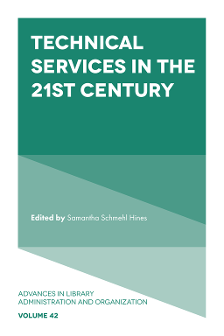
Index
Technical Services in the 21st Century
ISBN: 978-1-80043-829-3, eISBN: 978-1-80043-828-6
ISSN: 0732-0671
Publication date: 8 January 2021
Citation
(2021), "Index", Hines, S.S. (Ed.) Technical Services in the 21st Century (Advances in Library Administration and Organization, Vol. 42), Emerald Publishing Limited, Leeds, pp. 227-234. https://doi.org/10.1108/S0732-067120210000042017
Publisher
:Emerald Publishing Limited
Copyright © 2021 Emerald Publishing Limited
INDEX
- Prelims
- Introduction
- Guiding Principles for Technical Services through a Content Analysis of Strategic Plans
- More than Meets the Eye: Technical Services Work as Outreach
- Complex Adaptive Systems in Technical Services: A Functional Model for Assessing Institutional Alignment
- Process Mapping and High Performance Management in Technical Services
- Faculty Workload Guidelines in Technical Services
- Life Cycle Package Management for Print and Electronic Resources: Cross-training a Customer-oriented Technical Services Team
- Two Separate Worlds, One Shared Goal: An Exploration of Special Collections Catalogers' Reporting Lines and Institutional Organization
- You Are What You Measure
- Moving Toward BIBFRAME and a Linked Data Environment
- Data of E-Resources: Moving Forward with Assessment
- From Silo to the Web: Library Cataloging Data in an Open Environment
- The Death of the Big Deal and Implications for Technical Services
- Purchasing Models for Streaming Film: Attitudes and Motivation
- About the Authors
- Index